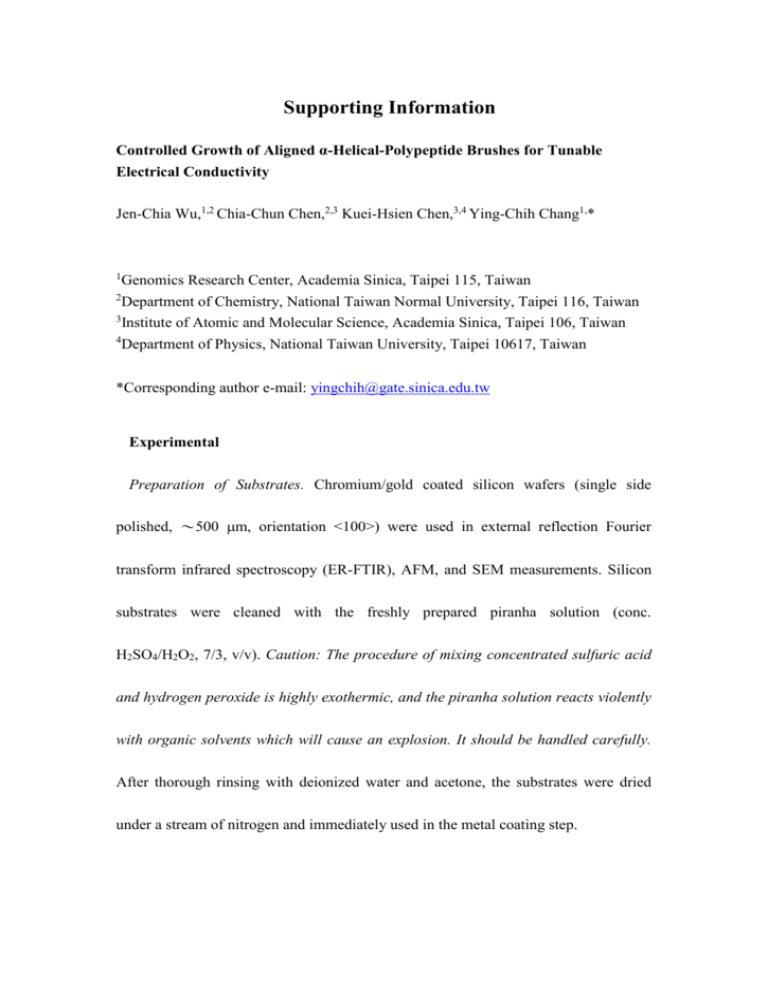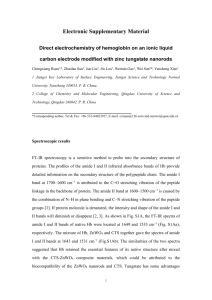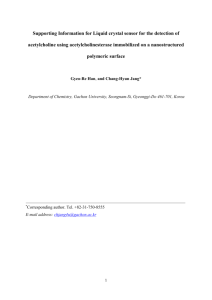Revised Supporting Information
advertisement

Supporting Information Controlled Growth of Aligned α-Helical-Polypeptide Brushes for Tunable Electrical Conductivity Jen-Chia Wu,1,2 Chia-Chun Chen,2,3 Kuei-Hsien Chen,3,4 Ying-Chih Chang1,* 1 2 3 4 Genomics Research Center, Academia Sinica, Taipei 115, Taiwan Department of Chemistry, National Taiwan Normal University, Taipei 116, Taiwan Institute of Atomic and Molecular Science, Academia Sinica, Taipei 106, Taiwan Department of Physics, National Taiwan University, Taipei 10617, Taiwan *Corresponding author e-mail: yingchih@gate.sinica.edu.tw Experimental Preparation of Substrates. Chromium/gold coated silicon wafers (single side polished, ~500 m, orientation <100>) were used in external reflection Fourier transform infrared spectroscopy (ER-FTIR), AFM, and SEM measurements. Silicon substrates were cleaned with the freshly prepared piranha solution (conc. H2SO4/H2O2, 7/3, v/v). Caution: The procedure of mixing concentrated sulfuric acid and hydrogen peroxide is highly exothermic, and the piranha solution reacts violently with organic solvents which will cause an explosion. It should be handled carefully. After thorough rinsing with deionized water and acetone, the substrates were dried under a stream of nitrogen and immediately used in the metal coating step. Preparation of Metal Coated Substrates. Reflective gold films were prepared by sequential deposition of 10 nm of chromium and 100 nm of gold onto silicon wafers with a physical vapor deposition coating system (ULVAC VPC-260F). The rates of deposition of chromium and gold were 0.2 and 0.5 Å/s, respectively. The pressure in the evaporator was maintained below 1 × 10-5 Torr throughout evaporation of the metals. The roughness of the substrate was 1.3 nm (characterized by AFM). Preparation of Self-Assembled Monolayers. Upon removal from the vacuum chamber, the gold-coated silicon wafers were immediately immersed into 1 mM ethanolic 2-aminoethanethiol hydrochloride solutions at room temp for 24 h.1 Upon removal from solution, samples were rinsed sequentially for 20 s each with ethanol and acetone, and then dried under nitrogen. Synthesis of Surface-Grafted Polymer Brushes. End-tethered poly-(-benzyl-Lglutamate) (PBLG) films were grafted on to the substrates by surface-initiated vapor deposition polymerization (SI-VDP) of N-carboxyanhydride of -benzyl-L-glutamate (NCA-BLG).2 The SI-VDP reaction was performed under 1.0×10-5-1.0×10-6 Torr, 20 min reaction time, 70 oC substrate temperature and 95 oC NCA-BLG evaporating temperature for the samples used as t-PBLG films. After the SI-VDP reaction was completed, the samples were soaked in a mixture of dichloroacetic acid (DCA)/ chloroform (2/8. v/v) for 30 min, washed with chloroform, and dried under a stream of nitrogen. Changing of the Molecular Orientation of t-PBLG films. The molecule chain orientation was changed by using the “Solvent Quenching” method that was published by Wang and Chang previously.3 Briefly, the “Solvent Quenching” method uses a good solvent (chloroform) to stretch out the molecular chains and bad solvent (acetone) to freeze the upright orientation molecule chains. After removing the film samples from the bad solvent, the samples were dried under a stream of nitrogen to complete the procedure of solvent quenching. Preparation of Spin Coated PBLG film. To prepare spin coated PBLG film, PBLG solutions were prepared by dissloveing PBLG powder (DP =169, Sigma) in chloroform with concerntration 1% (wt %) first. Then the PBLG solution was spin coated (Precision Spin Coater, Model KW-4A) onto the gold coated substrate at 3000 rpm for 30 s. Molecular orientation measurements. The ER-FTIR spectra of the end-grafted PBLG films on the gold coated substrates were recorded using a Nicolet Magna-IR 860 spectrometer with a clean aluminum coated substrate as the reference. 32 scans with a resolution of 4 cm-1 were collected for each sample. The spectra measurements were performed under dry air (Whatman FT-IR purge gas generator) purging to offset absorption of ambient moisture. Molecular structure imaging. All of the SEM images were acquired with a JEOL-JSM-6700F SEM at low voltage (8 kV). Samples were coated with platinum prior to imaging. To take the cross-sectional SEM image, a home made sample holder with 1 cm depth groove was used, and the substrate was tilted vertically and stuck on the side wall of the groove. Electric behavior analysis. AFM images and I-V curve measurements of the unidirectional PBLG films were obtained with a Veeco-MultiMode Scanning Probe Microscope AFM in tapping mode. Conductive-AFM mode was performed with a cantilever Tap-300E (Cr/Pt coated tip, tip radius = 25 nm, Budget Sensors, USA). Calculation of Average Tilt Angles of PBLG Brushes by ER-FTIR. The tilt angle of the helix axes from the surface normal were estimated from the D values, which is ratio of the integrated amide I (AI) to amide II (AII) regions from ER-FTIR spectra. The calculation of the tilt angle were carried out with equation (1),4 where K is the proportionality constant that relates the intrinsic oscillator strengths of the amide I and amide II vibrational modes. The value of K has been calculated from LB films of PBLG to be 1.5 0.2.5 The transition dipole of the amide I and amide II groups are anisotropic and form angles of 39 and 75 with the helical backbone, respectively.5 D = AI/AII = K (1/2 (sin<θ>sin39)2 + (cos<θ>cos39)2) / (1/2 (sin<θ>sin75)2 + (cos<θ>cos75)2) (1) FIG (S1). ER-FTIR spectra of the (a) SCPBLG, (b) UQt-PBLG, and (c) Qt-PBLG films on the Au substrate under nitrogen purge. The dotted lines in the spectra show the position of the amide I and amide II in the spectra. FIG. (S2). The results of taking first and second derivative of the I-V curve of Qt-PBLG. (a) First derivative vs. Bias and (b) Second derivative vs. Bias. Reference: 1. H. Duran, K. Ogura, K. Nakao, S. D. B. Vianna, H. Usui, R. C. Advincula 2. 3. 4. and W. Knoll, Langmuir 25, 10711 (2009). Y. Wang and Y. C. Chang, Langmuir 18, 9859 (2002). Y. Wang and Y. C. Chang, J. Am. Chem. Soc. 125, (2003). E. P. Enriquez, M. Y. Jin, R. C. Jarnagin and E. T. Samulski, Mater. Res. 5. Soc. Symp. Proc. 255, 423 (1992). M. Tsuboi, J. Polym. Sci. 59, 139 (1962).




